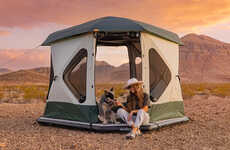
The 'Lattice Tent' Supports Plant Growth After Use
Michael Hemsworth — November 29, 2017 — Eco
References: yankodesign
The conceptual 'Lattice Tent' works to provide a very solid shelter for humans in the event of an emergency, while also being functional once it has been used for its intended purpose.
The tent features a lattice design (hence the name), which will provide a strong framework for equipment to be used on top including a radio antenna or rain-harvesting system. The exterior of the walls are made from an eco-friendly membrane that will allow plant life to break through once the tent is no longer needed as a shelter. The process only requires that a handful of seeds be tossed into it to start the growing process.
The 'Lattice Tent' is the design work of Rodney Adank, Andrew Drain, Michael Jones, Sam McCafferty and Lachlan McIntyre.
The tent features a lattice design (hence the name), which will provide a strong framework for equipment to be used on top including a radio antenna or rain-harvesting system. The exterior of the walls are made from an eco-friendly membrane that will allow plant life to break through once the tent is no longer needed as a shelter. The process only requires that a handful of seeds be tossed into it to start the growing process.
The 'Lattice Tent' is the design work of Rodney Adank, Andrew Drain, Michael Jones, Sam McCafferty and Lachlan McIntyre.
Trend Themes
1. Eco-friendly Emergency Shelters - Designing emergency shelters with eco-friendly materials and functions opens up opportunities for sustainable disaster relief solutions.
2. Multi-purpose Emergency Tents - Creating emergency tents with additional functions, such as rain-harvesting systems or radio antennas, presents opportunities for versatile and efficient disaster response.
3. Living Infrastructure in Emergency Shelters - Integrating plant growth and living infrastructure into emergency tents allows for post-disaster regeneration and sustainability efforts.
Industry Implications
1. Disaster Relief - Developing eco-friendly emergency shelters benefits the disaster relief industry, paving the way for sustainable and efficient response strategies.
2. Green Building - The use of eco-friendly materials and the integration of living infrastructure in emergency shelters contribute to the advancement of green building practices and innovations.
3. Sustainability Solutions - Creating multi-purpose emergency tents with sustainable features creates opportunities for the sustainability industry to provide innovative solutions for disaster response and recovery.
6.5
Score
Popularity
Activity
Freshness























